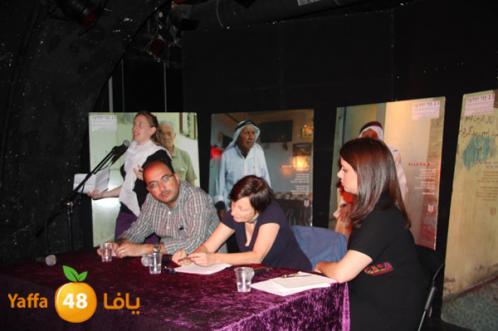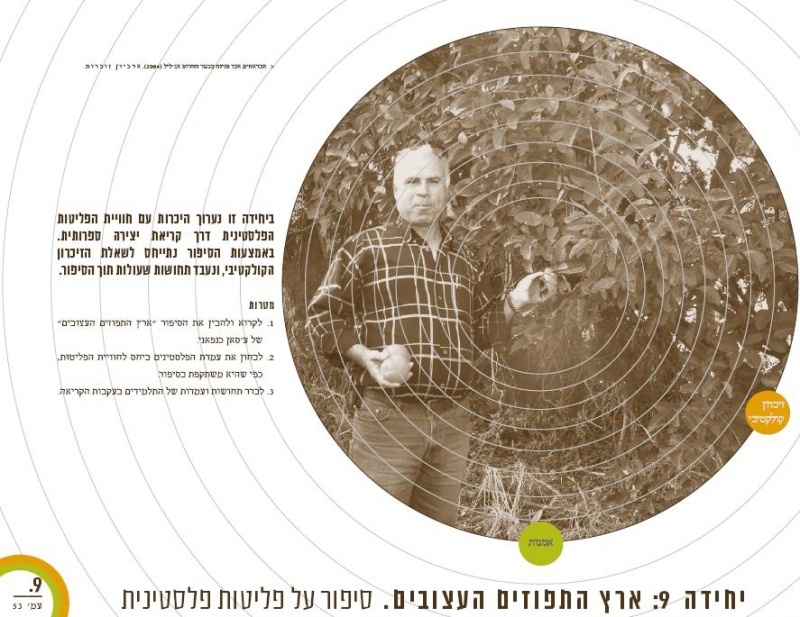Part 1: Coping, Memory and Community in the Post-Return Urban Space
(A) Fundamental Principles
- Jaffa is the microcosm of a tragedy that has transpired and still does also in other areas of Palestine.
- The actual Return of Palestinian refugees should lead to the emergence of culturally and ethnically heterogeneous urban spaces.
- Healing processes will take place in the political context of doing historical justice and implementing it on the ground. For the Palestinians, healing means renouncing their status as victims, whereas for the Jews it means renouncing their status as victimizers or perpetrators.
- The returning Palestinians will have to deal with their trauma of displacement, deportation and refugeehood, and long years without political rights. They will also need to mourn the loss of their worlds – for the refugees, this would be the pre-1948 world, but also that of the refugee camps and the Palestinian diaspora in general – the only home they have known. This mourning process will enable them to liberate themselves of the sense of helplessness associated with status as victims and set out on a new road free of trauma.
- The healing of the Jewish population will involve coping with their sense of persecution, a process of self-forgiving for injustices perpetrated, and acknowledgement of the suffering experienced by all parties to the conflict (albeit in different intensities) as a result of the Zionist-colonialist project. The Jews will also have to mourn for the loss of the Israeli social order, a process essential for the emergence of a healthy mixed society in the future.
- Together with those separate coping processes that will take into account the critical differences between the two communities, joint processes will also take place. Jews and Palestinians will undergo common emotional process that will culminate in their acknowledgement of the Other's trauma and pain, healing mourning, and recognition of the perpetrators' humanity.
(B) General Characteristics of the Coping and Healing Process
- Healing workshops. Over the course of several months, these will enable participants to present their personal stories which represent a collective experience and therefore carry deep social meaning.
- Emotional pioneers: Groups who would volunteer to lead such processes at a time when society would not yet be in an emotional place to allow them on a broader basis, and provide a model for others to follow.
- Emphasis on rituals that will facilitate public recognition of a painful collective history and of the complexity of the personal and collective narrative.
- Localized work: The process will take place in the local community context, based on the realization that assimilating healing processes in daily life is essential for their successful conclusion. The community represents a dynamic social circle diametrically opposed to the asymmetrical hierarchy in the form of "regime" or "authorities" on the one hand, and to the individualistic split characteristic of postmodern life on the other.
- Centers for the healing of memories which are more than just "museums" of suffering, and whose visitors are not passive observers supposed to take didactic messages. These are sites documenting multiple layers of memory, including reference to ambivalent memories of suffering, resistance, collaboration and cowardice. These sites will pose ethical dilemmas relevant to visitors from other countries, and will facilitate emotional response and independent thinking, as well as the personal development of activists who will act upon their learning in their communities of origin.[1]
(C) Based on these principles and characteristics, we suggest a prototypical community center that could be reproduced in other sites in the Jaffa-Tel Aviv metropolitan area and in Palestine in general, adjusted to local dynamics and community needs. This center will reflect the importance of the community dimension in the processes of Return and post-Return coping, memory and healing. Unlike the typical Zionist "absorption center", connotative of "reeducation", this will be a community resource facilitating the returnees' adjustment to the old-new place.
The proposed center could have at least some of the following functions:
- Workshops for the healing of memories
- Interactive museum
- Space for cultural activities, afternoon classes and language courses
- Psychosocial services and legal clinic
- Community gatherings, testimonies and public hearings, as well as performances enabling both victims and victimizers to enact their stories
- Daycare center
- Archive and database about the metropolitan area and its communities, including people search services
- Tours in the Jaffa-Tel Aviv area and a tourist information center
- Community empowerment through professional courses, community knowledge workshops and inviting community members to take part in redesigning their living space.
(D) Location
We propose locating the proposed complex on the site of the (former) Etzel (Irgun) House in today's Charles Clore Park, on the lands of Jaffa's northern Manshiyya Neighborhood. The complex will be composed of a central building surrounded by other buildings serving its various functions, including an amphitheater. The complex will be architecturally connected both to the Hassan Bek Mosque and to the sea, in the form of a monument dedicated to the masses refugees deported from Jaffa. We also propose to build an additional floor about the existing museum, and that remaining ruins of Manshiyya's houses be set apart and connected to Jaffa's Palestinian past, and to its future.
Part 2: Mechanisms of Return
(A) Fundamental Principles
- All refugees have the right to return to their homeland.
- Each refugee and displaced person has the right to return to their town or village of origin.
- The right to return to privately owned land does not necessarily mean returning to it in practice.
- Current tenants will not be forcibly evacuated.
- In practice, the Right of Return will be realized in various forms based on current uses.
- Property rights: Return to property in its strictly legal sense or acknowledgement of the asset's value. What problems will arise? How are we to deal with the problem of wealthy pre- or post-Nakba landowners, or such who have remained? How can we guarantee economic justice between returnees and "remainees"?
- Recognition of the refugees' property rights.[2]
- Distinction between urban areas where there is no land ownership beyond that of an apartment or house and rural areas where individuals or the entire village own tracts of land around it.
- Each village and its community will be considered an independent, separate planning unit – each will be considered on a case-by-case basis. Whenever a given village will not have enough space to house all returnees, they will be compensated through country-wide public housing projects.[3] In any case, planning will be carried out jointly with the returnees, according to their needs and desires.
- Despite the above, planning will also take into consideration the new realities in the communities and certain guiding principles, including the allocation of land for schools, hospitals and other public uses.
- "Community property" will be recognized in certain rural areas. For instance, all Salame's lands will be returned to their inhabitants, who will jointly decide on their uses, taking into consideration socioeconomic changes in the country and worldwide after 1948, in particular the reduced importance of the agricultural sector in the economy.
- Current inhabitants of rural areas such as Salame will become the returnees' (rather than the state's) protected tenants, and will not lose their rights.
- In small villages, the dilemma is simpler: lands will be returned to families and the principle of housing for all will be fully implemented.
(B) Solutions for the Case of Irreversible Use of Refugee Properties
1. Whereas refugees' ownership rights will be recognized, no existing buildings will be demolished. We propose two solutions:
(1) The new state will buy the land from the refugee at its full value[4] but its current use will remain unchanged and the principle of non-evacuation will be adhered to.
(2) The ownership rights of each returnee will be officially recognized, but compensation will not necessarily be based on present value.[5]
2. In the case of al-Shaykh Muwannis, for example, clearly lands will not be returned to refugees at the expense of the Tel Aviv University, but property rights will have to be recognized and a new arrangement considered: the university or the state will buy or lease the lands and pay the refugees for the continued use of the land, as well as compensate them for the use made of it in the past.
(C) Refugee Participation in the Planning Process
- When and how will the refugee community convene to decide its future?
- Existing diasporic communities can already plan for their future compensation before their actual Return.
- If the process takes too long, whoever prefers an immediate solution in the form of public housing should be offered such an option, based on consultation, with priority to settling in their village.
- The present condition of the village or town should be presented to the community as a basis for joint decision on the future of remaining lands.
- Before planning, all lands and all refugee demands must be thoroughly studied.
(D) Existing Palestinian Houses Currently Occupied by Displaced Jews or Palestinians
- The refugee will have the right to the property.
- The secondary occupant will be asked to leave the property in return for an alternative house or its monetary equivalent.
- The secondary occupant will be entitled to refuse. In this case, the owner will be the refugee but the tenant will remain on the property for the remainder of his or her life, without the option of inheritance. Any descendants still living in the house will receive alternative housing if necessary.
(E) Urban Planning
- Towns will be expanded in order to enable as many refugees to return to their towns of origin, in the form of public housing.
- All available land will be allocated to multiple-story housing projects.
- Military sites and buildings in the Jaffa-Tel Aviv area, such as the Kirya, will be converted to residential neighborhoods and properties.

השקת מסמך יאפא / اطلاق وثيقة يافا


